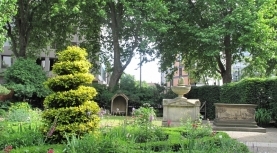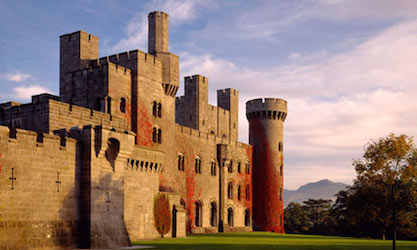Q. Where can you find a storage facility made from Hempcrete, an innovative material made from hemp and lime?
A. The Science Museum at Wroughton, which won the sustainability award at the 2013 Museum and Heritage Awards.
Like many other national museums, the Science Museum only displays 8% of its collections to the public – there is just not enough space to display any more. The other 92% of the collection is housed in storage facilities. One of these storage sites is a former airfield near Swindon, which holds 16,000 objects including large scale items such as aeroplanes, trains and cars in what were formerly aircraft hangars. The Hempcrete facility was designed as a radical new solution to protecting objects including horse-drawn carriages, fine art works, wooden ship models and paper archives. Many of these objects are sensitive to changing climate conditions such as light, heat and moisture so providing the right environment is essential to prevent deterioration.
The solution was to create a zero-carbon storage building from hemp and lime – low carbon natural materials which provide temperature and humidity buffering and ensure that the museum’s collections are maintained for future generations.
Q. What do you need to do to win a Gold Award in Green Tourism?
A. Follow the example of Killhope Lead Mining Museum in County Durham, which achieved 95% in the 2013 Green Tourism Scheme
The Green Tourism Scheme is the largest green accreditation scheme in the world. Any business that has been accredited ‘green’ will have implemented initiatives across its business that contribute a significant benefit to the environment and to responsible tourism. Many of these things may be behind the scenes such as energy efficient boilers, insulated lofts or grey water recycling, but there are many fun activities that you can expect to find too. For example, your organisation should be able to advise visitors about traditional activities nearby, the best places to sample local food or buy craft products, or even help them to enjoy a ‘car-free’ day out.
There is a ‘working towards green tourism’ logo for organisations which are part of Green Start – a framework for any tourism business wishing to make an initial commitment to green tourism. It’s designed to provide operators with a springboard to accreditation by one of the VisitBritain validated accreditation schemes. By adopting Green Start, a business is signalling to visitors that it recognises the importance and value of sustainable good practice. See http://www.green-tourism.com/business/ for further details of the scheme
Q. Who is supporting Operation Green Museums, and what is it?
A. In 2012, London’s Garden Museum undertook to fund four sustainability trainees with the help of a Heritage Lottery Fund Skills for the Future grant.

“The aim of this project is to equip young people (four over four years) passionate about both heritage and the environment with the knowledge, skills and advocacy required for a career which will enrich both the individual and the Museum sector through developing sustainability in Museum practice.”
The Garden Museum wants to show that sustainability should be integral to the collective of a successful museum. It is the first traineeship of its kind in museums, and by 2015 four trained individuals will be applying skills and sharing ideas across the country. Projects led by trainees include the establishment of a Zero Waste to Landfill strategy at the museum, an Eco Weddings events package, a Community Garden, the design and building of an insect hotel which was used as an educational resource, running a newsletter for the volunteer team and developing and delivering educational workshops.
The current trainee, Frances Reed, has been working on a range of projects from selling flowers grown in the cutting garden from the flower cart, to co-coordinating the Winter Eco-Design fair, Diggin Design. Recruitment is now open for the final trainee who will begin in June 2014
Q. Who is looking to the past to inform a sustainable future in historic estates?
A. National Trust Wales

Properties run by National Trust Wales include mansions using 1500 litres of oil a day. Others have 100 year-old heating systems and some of the oldest infrastructure in UK, so its mission to reduce energy use went through several stages. First of all, it had to survey, review and investigate. The next stage was to monitor. It installed smart meters and moved from 99% estimated billing to 99.5% actual. Then it devised plans to calculate the cost of different technologies for every site.
Now the National Trust is going into partnership with communities to see if that pattern can be repeated with modern technology. The transformational change taking place within National Trust Wales has made it the clear winner in the energy category. Hydro is not all the National Trust is discovering, as it focuses on sustainable energy. It is also learning about sustainable buildings such as Pontbremydyr, a 300-year-old cottage in mid-Wales that has all the ingredients of a modern eco-house. It is made of breathable clom (clay and straw), breathable lime paints, has a straw roof and small low heat-loss windows. All the materials used to build it come from a few hundred metres away.
A more futuristic scheme also draws on long-established knowledge that seawater and the ground retain heat. On this basis, the charity is planning what could be the UK’s first large-scale marine source heat pump at the 18th century mansion, Plas Newydd, on the Menai Strait. A marine-sourced heat pump would mean the Trust no longer has to buy and store the 128,000 litres of heating oil needed to keep this famous attraction going. The National Trust Wales embarked on the programme, Fit for the Future, to focus on managing resources and reducing its environmental impact. Over the past five years, the programme has incorporated training workshops, energy efficiency and large-scale investment. An underlying principle of the programme is to share what the Trust has learned and dispel myths that historically significant estates are difficult to treat.
The charity can now carbon budget every large property in Wales and based on 2009-2010 figures, it has cut overall energy use by 41% and carbon production by 46% a year. Its approach to energy has proved so successful that the programme has expanded to cover all its resources, even paper clips. Water use and bills have fallen by 42%, winning National Trust Wales the Waterwise award for innovation.
The company is hosting local sharing workshops to enable the community to become sustainable in transport and energy. In another innovation, it is forming commercial partnerships with communities on energy projects and working with social housing groups.
Q. Which UK museum became the first to receive ISO 14001 accreditation?
A. The Natural History Museum in 2005, across its whole estate.

Admittedly Environmental Management Systems are not at the exciting end of sustainability. However, they are very useful tools – as the saying goes, ‘You can’t manage what you can’t measure.’ One of the best places to start your sustainability journey is to find out exactly how much energy you use such as how much water you use, what happens to your waste etc. ISO14001 is probably the best known and certainly the most popular standard for Environmental Management. It provides organisations with a framework to allow them to set up an effective environmental management system. As with other ISO 14000 standards, this is voluntary, its main aim being to assist companies in continually improving their environmental performance, while complying with any applicable legislation. Organisations are responsible for setting their own targets and performance measures, with the standard serving to assist them in meeting objectives and goals and in the subsequent monitoring and measurement of these.
Improving your organisation’s efficiency can provide benefits such as a reduction in waste, consumption of resources, and operating costs. The Eco-Management and Audit Scheme (EMAS) is a voluntary environmental management instrument, which was developed in 1993 by the European Commission. It enables organisations to assess, manage and continuously improve their environmental performance. The scheme is globally applicable and open to all types of private and public organisations. ISO 14001‘s requirements are very similar to those of EMAS, but there are additional requirements, including:
· stricter requirements on the measurement and evaluation of environmental performance against objectives and targets.
· government supervision of the environmental verifiers
· strong employee involvement; EMAS organisations acknowledge that active employee involvement is a driving force and a prerequisite for continuous and successful environmental improvements.
· environmental core indicators creating multi-annual comparability within and between organisations
· mandatory provision of information to the general public
· registration by a public authority.
UK government funded bodies of a certain size are required to have an EMAS. Currently, more than 4,600 organisations and more than 7,900 sites are EMAS registered.
Q. How are South Kensington institutions working to become carbon neutral?
A. By making use of a natural underground aquifer and ATES technology.
This ambitious carbon reduction plan brings together all the organisations along Exhibition Road: the Royal Albert Hall, The Royal Academies of Art and Music, The Royal Geographical Society. Imperial College, and the Science, Natural History and Victoria and Albert Museums. Making use of the natural aquifer under these buildings, heat will be slowly exchanged from one end to the other, cooling in summer and warming in winter, so saving hundreds of tonnes of CO2. As well as reducing energy use, the project also reduces the carbon intensity of heating and cooling.
Launched in 2011 at the Natural History Museum by the Rt Hon. Greg Barker MP, Climate Change Minister, research continues to enable this amazing scheme to come to fruition. More details on the scheme can be found here http://www.cynergin.com/news-10-underground-network-could-help-south-kensington-institutions-become-carbon-neutral.html
This article is based on a seminar presentation at the 2014 Museums + Heritage Show at Olympia. Save the date for next year’s show 29-30th April.
Back to top




